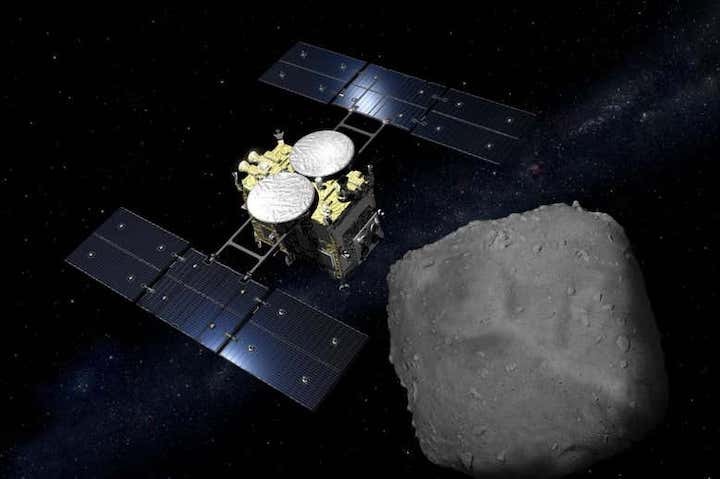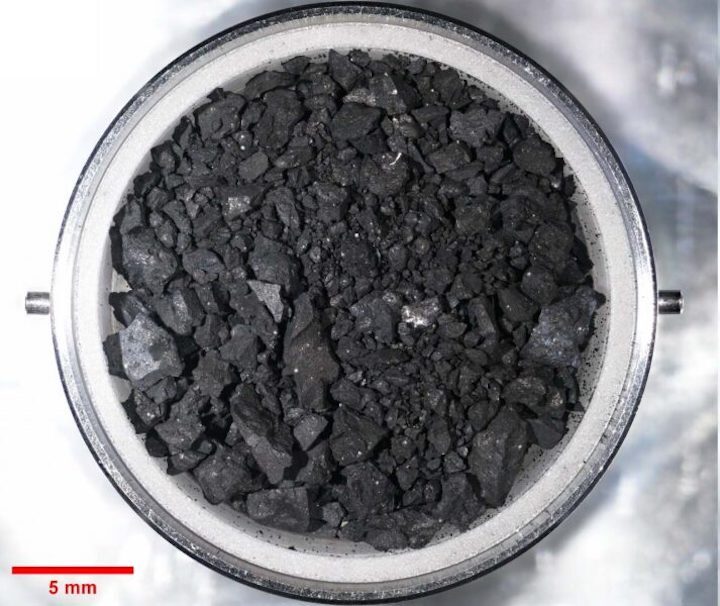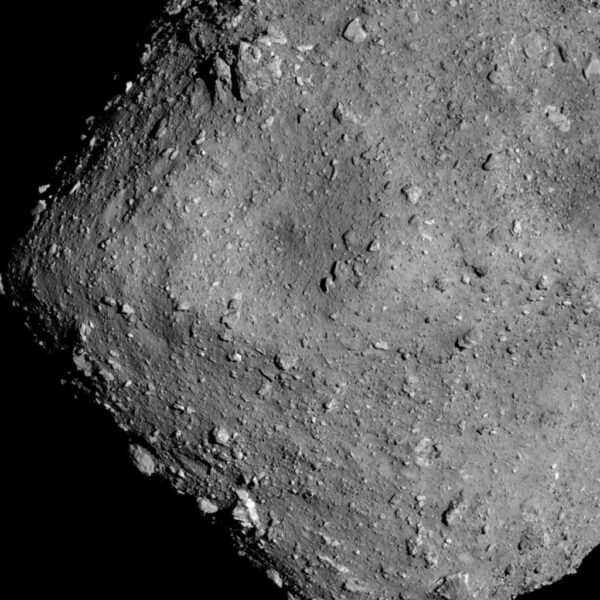22.12.2021
Last year, Japan’s Hayabusa 2 asteroid explorer returned samples from the asteroid Ryugu, and now the first analysis of the rock shows it has a primitive composition and a curiously dark colour

The asteroid Ryugu contains some of the darkest and oldest material in the known solar system, according to a pair of preliminary analyses of samples collected from the space rock.
The samples, only the second to be taken from an asteroid, were extracted by Japan’s Hayabusa 2 asteroid explorer in 2019 and returned to Earth last year.
Totalling about 5.4 grams of material and taken from Ryugu’s outer surface, the rock samples appear to have many minerals and compounds in common with meteorites found on Earth. But they also contain a raft of unusual compounds, such as organic and water-bearing molecules.
“Although most of these compounds are minor in terms of quantity – a few per cent at maximum – they have a high potential in tracing some of the processes that occurred in the earlier stages of the formation of the solar system and, later on, Ryugu’s parent body,” says Cédric Pilorget at the University of Paris-Saclay, France, a member of the international team of researchers who studied the samples and lead author of the first analysis.
In the second analysis, researchers led by a team at the Japan Aerospace Exploration Agency used several non-destructive techniques to examine the samples, including studying them using hyperspectral microscopes – which involves capturing hundreds of images of a sample under light at different wavelengths to extract information about the composition of the minerals it contains – and using optical spectrometry.
These analyses confirmed many of the observations made by Hayabusa 2’s remote sensors in 2019, when the samples were collected some 300 million kilometres from Earth.
In addition, the samples were found to be very dark in terms of the light they reflected – even darker than meteorites in collections, indicating either a unique chemical make-up, or that Earth’s atmosphere somehow brightens meteors as they descend.
The second analysis also revealed that Ryugu is highly porous, which could be a feature it gained during its formation from a series of collisions and break-ups of ancient asteroids.
The presence of water-bearing compounds and carbonates, meanwhile, indicates that Ryugu comes from the edge of the early solar system, while the presence of nitrogen-based compounds could help specify Ryugu’s origin further.
The absence of some compounds, including calcium and aluminium-based minerals, suggests Ryugu wasn’t formed in the very earliest, high temperature regime of the solar system, says Ashley King at the Mineral and Planetary Sciences Division of the Natural History Museum in London, who wasn’t involved in the research.
Although the preliminary analyses don’t specify an exact age for Ryugu, the presence of well-preserved, dark, carbon-based compounds implies, that it has been around since close to the dawn of the solar system, almost 4.6 billion years ago, says King.
“They’re the most pristine materials that we can get hold of and they’re the things that take us back to time zero in the solar system,” he says.
Journal references: Nature, DOI: 10.1038/s41550-021-01550-6 and DOI: 10.1038/s41550-021-01549-z
Quelle: NewScientist
+++
SAMPLES FROM ASTEROID RYUGU ARE MOST PRIMITIVE MATERIAL WE'VE FOUND
The material that the Hayabusa 2 spacecraft returned from asteroid Ryugu is the most pristine sample we’ve ever gotten our hands on.

Two groups analyzed a sample of black-colored pebbles and fine powder from the near-Earth asteroid Ryugu. Yada et al. / Nature Astronomy 2021
Tests at two laboratories show that the dark grains that the Hayabusa 2 spacecraft collected from the carbon-rich near-Earth asteroid 162173 Ryugu are the most primitive materials known in the solar system.
“In this body you see hydrated materials and signs of organics from very early in the formation of the solar system — that's exciting!” says Deborah Domingue (Planetary Science Institute), who was not involved in those studies but did earlier analysis of remote sensing data of Ryugu.
Planetary scientists have long wanted to study material from the remains of the primordial protoplanetary disk that linger in interplanetary space. However, falling through the atmosphere destroys most incoming meteoritic material, and objects large enough to reach the ground as meteorites arrive badly scorched and often shattered. The only way to obtain pristine material is to collect samples in space and bring them to the ground. Previous missions have returned samples of the Moon, Comet 81P/Wild 2, and rocky near-Earth asteroid 25143 Itokawa.
The troubled Hayabusa 1 mission delivered less than a milligram of dust from Itokawa in 2010, but it inspired a follow-on mission to Ryugu, which returned a 5.4-gram sample a year ago. That may not seem like much from a kilometer-wide asteroid, but the size was a welcome surprise to Toru Yada (Japan Aerospace Exploration Agency), who had been expecting only 100 milligrams.
Yada headed a team studying the physical structure of the sample, publishing the results in Nature Astronomy on December 20th. The lab tests largely confirm remote sensing results but resolve questions and add important details about Ryugu.

JAXA
Yada’s group reported grains ranging from about eight millimeters in size down to submillimeter-scale dust. They measured the particles’ albedo (reflectivity) to be about 2% at visible and near-infrared wavelengths, confirming remote-sensing results that the asteroid’s surface is darker than most meteorites. They also observed infrared absorption signatures of organic compounds and moisture that were probably present back when the grains first coalesced out of the protoplanetary disk.
The researchers also found the material to be extremely porous. Its average bulk density is lower than any meteorite ever found on Earth, though that’s not surprising because such porous material wouldn’t be expected to survive falling through the atmosphere. The team didn’t find chondrules or other inclusions formed by the solidification of molten materials — signs that the grains have survived for billions of years without being significantly altered by external heat or moisture.
In a second study published in Nature Astronomy, Cedric Pilorget (University of Paris, South) led a group conducting spectral analysis, which showed strong evidence of hydrated minerals and organic compounds. Their hyperspectral microscope found evidence of carbonates and compounds rich in nitrogen and hydrogen. Such species turn to vapor if they spend too much time close to the sun , so the compounds probably formed farther out from the Sun.
“These two papers are really fundamental, establishing that this is a highly primitive body,” says Domingue. With more of the material to be distributed to other labs, she says, “these samples are going to change our understanding of the building blocks for planets.”
Another sample expected to exceed 400 grams is now on its way from 101955 Bennu, another near-earth asteroid thought to include volatile compounds and pristine material. NASA’s OSIRIS-REx spacecraft collected the sample in October 2020 and is to drop it off on Earth in September 2023. If all goes well, that sample should tell us even more about planetary evolution.
Quelle: Sky&Telescope
